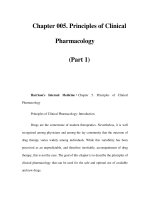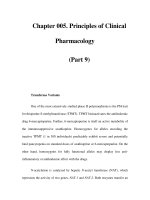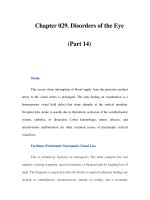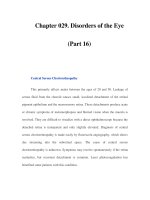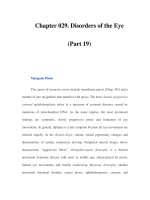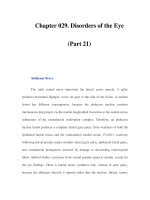Chapter 114. Molecular Mechanisms of Microbial Pathogenesis (Part 11) pps
Bạn đang xem bản rút gọn của tài liệu. Xem và tải ngay bản đầy đủ của tài liệu tại đây (12.96 KB, 5 trang )
Chapter 114. Molecular Mechanisms
of Microbial Pathogenesis
(Part 11)
Transmission to New Hosts
As part of the pathogenic process, most microbes are shed from the host,
often in a form infectious for susceptible individuals. However, the rate of
transmissibility may not necessarily be high, even if the disease is severe in the
infected individual, as transmissibility and virulence are not linked traits. Most
pathogens exit via the same route by which they entered: respiratory pathogens by
aerosols from sneezing or coughing or through salivary spread, gastrointestinal
pathogens by fecal-oral spread, sexually transmitted diseases by venereal spread,
and vector-borne organisms by either direct contact with the vector through a
blood meal or indirect contact with organisms shed into environmental sources
such as water. Microbial factors that specifically promote transmission are not
well characterized. Respiratory shedding is facilitated by overproduction of
mucous secretions, with consequently enhanced sneezing and coughing. Diarrheal
toxins such as cholera toxin, E. coli heat-labile toxins, and Shigella toxins
probably facilitate fecal-oral spread of microbial cells in the high volumes of
diarrheal fluid produced during infection. The ability to produce phenotypic
variants that resist hostile environmental factors (e.g., the highly resistant cysts of
E. histolytica shed in feces) represents another mechanism of pathogenesis
relevant to transmission. Blood parasites such as Plasmodium spp. change
phenotype after ingestion by a mosquito—a prerequisite for the continued
transmission of this pathogen. Venereally transmitted pathogens may undergo
phenotypic variation due to the production of specific factors to facilitate
transmission, but shedding of these pathogens into the environment does not result
in the formation of infectious foci.
In summary, the molecular mechanisms used by pathogens to colonize,
invade, infect, and disrupt the host are numerous and diverse. Each phase of the
infectious process involves a variety of microbial and host factors interacting in a
manner that can result in disease. Recognition of the coordinated genetic
regulation of virulence factor elaboration when organisms move from their natural
environment into the mammalian host emphasizes the complex nature of the host-
parasite interaction. Fortunately, the need for diverse factors in successful
infection and disease implies that a variety of therapeutic strategies may be
developed to interrupt this process and thereby prevent and treat microbial
infections
Further Readings
Camilli A, Bassler BL: Bacterial small-
molecule signaling pathways.
Science 311:1113, 2006 [PMID: 16497924]
Finlay BB, McFadden G: Anti-
immunology: Evasion of the host immune
system by bacterial and viral pathogens. Cell 124:767, 2006 [PMID: 16497587]
Han J, Ulevitch RJ: Limiting inflammatory responses during activation of
innate immunity. Nat Immunol 6:1198, 2005 [PMID: 16369559]
Kawai T, Akira S: Innate immune recognition of viral infection. Nat
Immunol 7:131, 2006 [PMID: 16424890]
Knirel YA et al: Structural features and structural variability of the
lipopolysaccharide of Yersinia pestis,
the cause of plague. J Endotoxin Res 12:3,
2006 [PMID: 16420739]
Mendes-Giannini MJ et al: Interaction of pathogenic fungi wi
th host cells:
Molecular and cellular approaches. FEMS Immunol Med Microbiol 45:383, 2005
[PMID: 16087326]
Pizarro-
Cerda J, Cossart P: Bacterial adhesion and entry into host cells.
Cell 124:715, 2006 [PMID: 16497583]
Spear PG et al: Different receptors
binding to distinct interfaces on herpes
simplex virus gD can trigger events leading to cell fusion and viral entry. Virology
344:17, 2006 [PMID: 16364731]
Takahashi K et al: The mannose-
binding lectin: A prototypic pattern
recognition molecule. Curr Opin Immunol 18:16, 2006 [PMID: 16368230]
Bibliography
Abe A et al: Type-
III effectors: Sophisticated bacterial virulence factors. C
R Biol 328:41, 2005
Kobasa D, Kawaoka Y: Emerging influenza viruses: Past and present. Curr
Mol Med 5:791, 2005 [PMID: 16375713]
O'Donnell RA, Blackman MJ: The role of malaria merozoite proteases in
red blood cell invasion. Curr Opin Microbiol 8:422, 2005 [PMID: 16019257]

